|
I am listening to the music in my iPod at 4:00 a.m. It is totally dark
outside. At home the morning paper must already have been delivered by
a nice uni student of first grade in the job early every morning.
No sound of rain, as a matter of fact. I could have seen the sky full of
stars. I wonder why I did not get up.
Switched on the TV at 5:30 and began watching "Good morning"
program. Still dark outside.
Opened the curtain of the window and some vague outline appeared in the
image covered with slight snow on top.
But that doesn't mean I recreated the real view through my eyes because
of my poor ability. Look at the picture half of my regret.
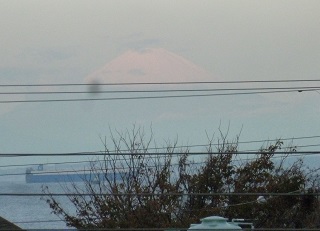
I decided to soak in the hot spring bath.
The bath house is in the annex connected by the tasteful corridor.
As I made it sure last night, I could take pictures this morning.
I happened to stay in Kajiya Inn because it is near the ropeway to Mt.
Nokogiri.
More than that it gave me an unexpected merit.
Though my stay was only from the previous evening to the morning, the inn
impressed me deeply. I leave my feeling in the last 4th chapter.
Mt. Nokogiri & Nihonji Temple
Our couple arrived at the ropeway station in 5 minutes from Kajiya Inn.
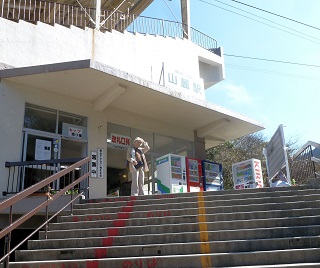
Got on the 9:30 cable-car and reached the top after 4 minutes.
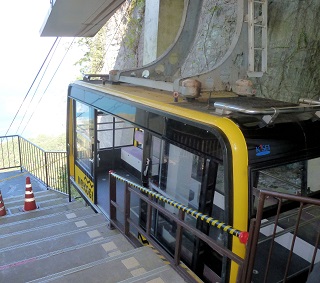
The west gate to Nihonji Temple was down the stone steps for a few minutes.
The top of Mt. Nokogiri seems to be a plateau with each gate at north,
south, east and west into the precincts of about 330 thousand square meters
of Nihonji Temple.
To state my conclusion first, a network complex of the approaches to the
temple consisted of 2,639 granite-stone steps and natural steep slopes,
which made me dead tired.
- - - - - -
After continuous upper slopes of stone steps for 20 minutes, the big sculpture
of Hundred-shaku Kannon appeared. It is about 30 meters high and one of the highlights in the
precincts of Nihonji Temple.
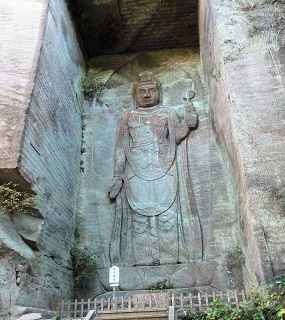
This kannon sculpture was carved on the rock face of the quarry for 6 years and completed in 1966. Its height is hyaku-shaku (a hundred-shaku), that is about 30 meters.
It was made for the repose of the victims during the 2nd World War and
the world peace. It is now a guardian angel of traffic safety.
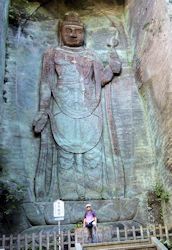 It was really worth watching. The picture right was taken by my wife. What
a contrast! Doesn't a nice guy look as tiny as an ant? It was really worth watching. The picture right was taken by my wife. What
a contrast! Doesn't a nice guy look as tiny as an ant?
Mt. Nokogiri ( Mt. Saw) was named as such, because the rock faces after
quarrying stones looked like sharp saws. There were several remains of
such works.
This quarrying work is said to have started in the latter half of Edo period
(1603-1868) and the stone material is tuff sand stone. The stones were
processed to stone lanterns, charcoal stoves, gravestones, stone Buddhas,
etc. and delivered to Edo or Tokyo (after Meiji period).
It had to be ended by the spread of cement at the beginning of Showa period.

The top of Mt. Nokogiri (329 meters high) was after 10-minute walk from
Hundred-shaku Kannon.
Mt. Nokogiri is so low that the name "mountain" sounded a little
odd to me before the trip.
Even very low, to the contrary, it made me feel something never easy only
during walking for 10 minutes from Hundred-shaku Kannon. What if I had
not made use of the 4-minute ropeway from the foot?
10 minute-walking from Hundred-shaku Kannon was only the first step. The
mountain was going to give me its cruelty as much as possible while walking
around Nihonji Temple.
I found a well-done explanation on Mt. Nokogiri in the English Wikipedia
as follows.
|
The mountain runs east to west, having the characteristic sawtoothed profile
of a Japanese saw. It falls steeply into Tokyo Bay on its western side, where it is pierced
by two road tunnels and a rail tunnel, carrying the Uchibo Line south from
Futtsu to Tateyama. Both features are due in part to the mountain's history
as a stone quarry in the Edo period, the marks of which are still picturesquely
evident.
The western side of the mountain is also the site of the sprawling Nihonji
Temple complex, which is the home of two Daibutsu sculptures - a huge seated
carving of Yakushi Nyorai that at 31.05 metres (101.9 ft) tall is
the largest pre-modern, stone-carved Daibutsu in Japan, and the "Hundred-shaku
Kannon", a tall relief image of Kannon carved into one of the quarry
walls - as well as 1500 hand-carved arhat sculptures, which combined with
the spectacular scenery of the Boso Hills and Tokyo Bay, make Mt. Nokogiri
a popular tourism destination.
The temple is accessible by road and by a cable car, the Mt. Nokogiri Ropeway,
which runs from Hamakanaya Station on the JR Uchibo Line to a lookout deck
near the top of the temple precincts.
The western end of the mountain falls precipitously into Tokyo Bay, where
Cape Myogane is a good place to watch large ships pass through Uraga Channel
at sunset.
|
I decided to explain what I saw in Nihonji Temple in the next chapter,
as it may become a little too long here. The title will be "Kenkon-zan
Nihonji Temple". You will see why its first name is "Kenkon-zan"
later.
- - - -
After 4 hours in the huge precincts of Nihonji Temple, we got down to the
foot in ropeway
Walking along the beach to Hamakanaya Station, we were looking around for
some restaurant. Both Emiko and I would like to eat some other lunch than
seafood, remembering the yesterday's big lunch at Banya.
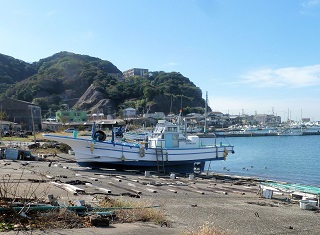
"Ramen or something light....."
A ramen store appeared on the coast side, as guessed Emiko's wish.
An old small lady of our age with her back bent was managing the store.
She talked to us friendly.
"I have been helping my husband of a fisherman since we were married
40 years ago."
"We always get up before dawn around 3 o'clock and take breakfast.
Then my husband goes to the sea. I do miscellaneous works related to the
fishing and the store, and do farmwork. Those works finished, I go shopping
at the market. Before lunch, I open my ramen store. When my husband returns
from the sea, I help him take his game of the day to the market. ...."
I ordered a seafood ramen in the result of being interested in her story.
The noodle soup with a number of seafood her husband caught went to my
stomach without my noticing.
Her story also made me recall my childhood.
My father Shigezo was an owner of the pearl-divers' boat since he stopped
a pearl diver on the Arafura Sea near Australia at the age of 33 after
17-year service. But he did not continue a fisherman, while he enjoyed
his hobby of rowing his small boat and catching fishes and marine life.
My mother Kumano delivered such marine products to neighbors and relatives.
My parents mainly managed a grocery and liquor store. Their another work
was to cultivate the wheat field on the hill. We 3 children helped them
getting their flattery.
- - - -
The old lady drew us into her heart-warming story with Boso dialect. It
was already 15:00. That meant we stayed here as long as 1 hour and a half.
We left the ramen shop, while the lady was reluctant to part from us.
The local train from Hamakanaya Station at 16:00 ran slowly on the Uchibo
Line until Soga Station.
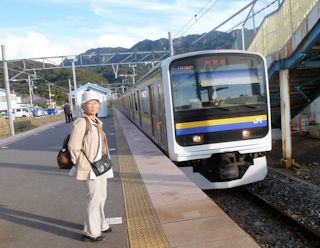
Changed to Keiyo Line for Shin-Urayasu Station where we arrived before
19:00, spending nearly 3 hours in train totally.
I will devote myself to the travel essay this time from tomorrow, starting
with the arrangement of a lot of pictures.
Pictures on Mt. Nokogiri, October 16, 2014
|